Menus
- Damn difficult and terribly expensive
- Gilera 500 replica
- Liberati won four of six Grand Prix in 1957
- Sacchi paved the way for Rossi to enter the GP circus
- Pirro Loreti for engine and body
- History of the Gilera engine
- Water-cooled compressor motor assembled everything
- Remor went over to MV Agusta
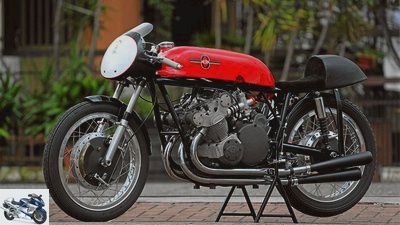
Oxley


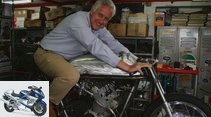
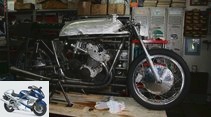
19th photos
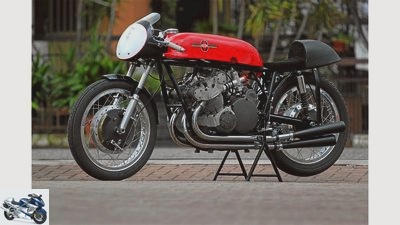
Oxley
1/19
Giampiero Sacchi’s lifelong dream has always been to rebuild the legendary Gilera four-cylinder racing machine with which Libero Liberati won the 500 World Championship in 1957.
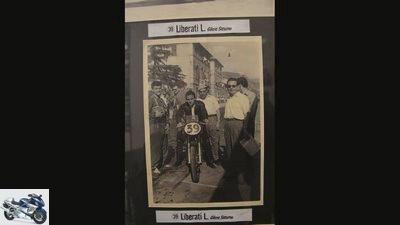
Oxley
2/19
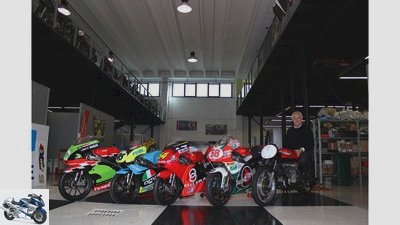
Oxley
3/19
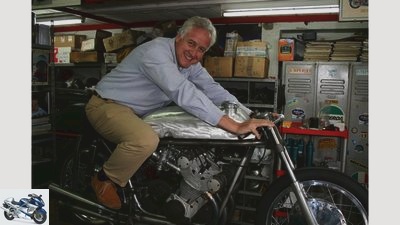
Oxley
4/19
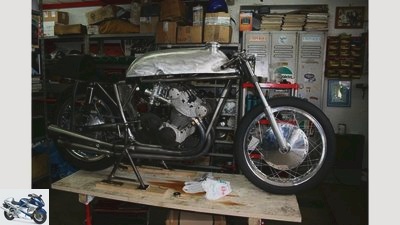
Oxley
5/19
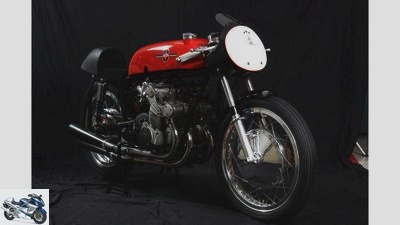
Oxley
6/19
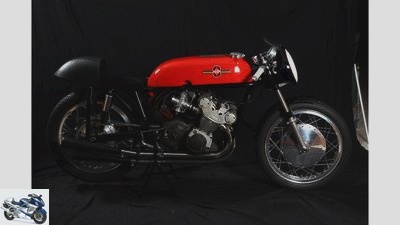
Oxley
7/19
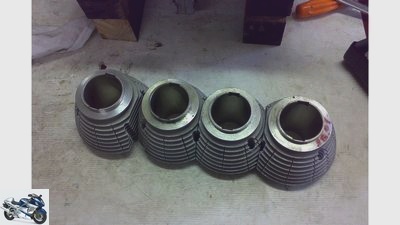
Oxley
8/19
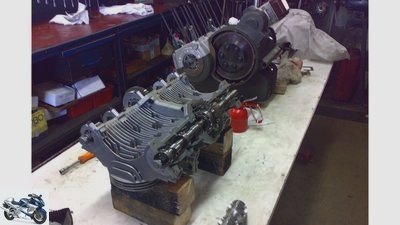
Oxley
9/19
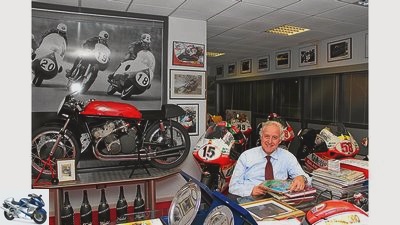
Oxley
10/19
Very close: Sacchi in the office of the Ioda racing team. The four-cylinder Gilera is the crowning glory of his great collection of racing motorcycles.
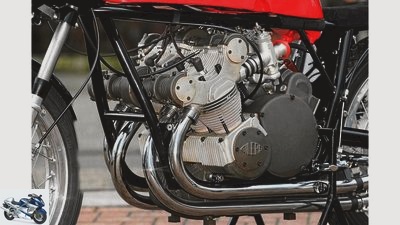
Oxley
11/19
In contrast to the original, Gilera’s unmistakable four-cylinder should not hide behind a full fairing in the replica.
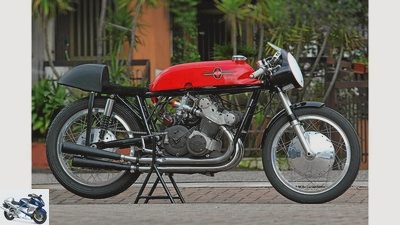
Oxley
12/19
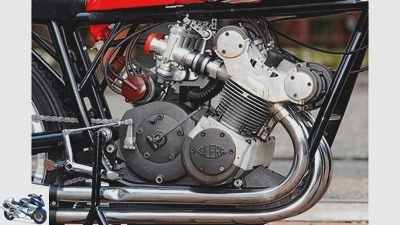
Oxley
13/19
An engine as a sculpture: Gilera’s unmistakable four-cylinder with its symmetrical structure and curved lines is a feast for the eyes.
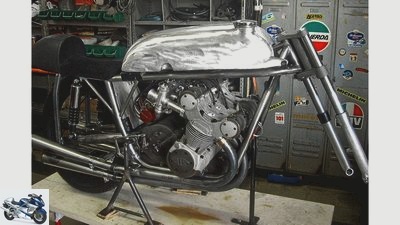
Oxley
14/19
… and the slowly taking shape machine.
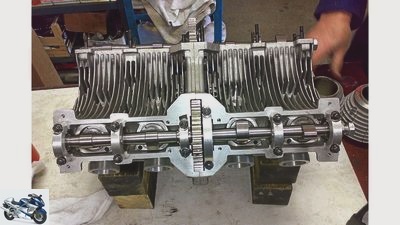
Oxley
15/19
… The camshafts with the central gear drive …
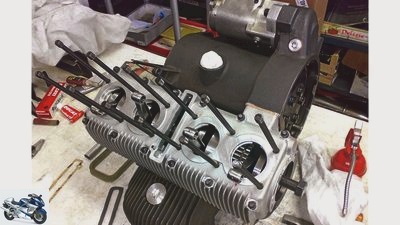
Oxley
16/19
Exclusive photos of the construction of the replica in Loreti’s workshop: The substructure of the sand-cast engine housing with crankshaft …
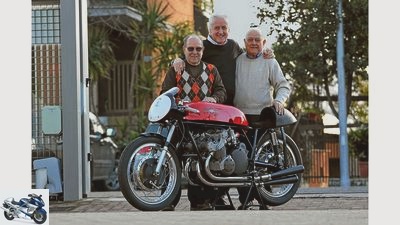
Oxley
17/19
Proud of their work: Sacchi with Liberati’s former mechanic Pirro Loreti (left) and the former MV and Gilera driver Remo Venturi (right).
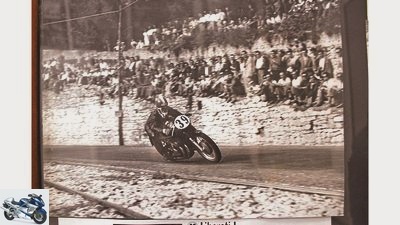
Oxley
18/19
On the way to victory: Libero Liberati on the four-cylinder Gilera at the Cervara road race.

Oxley
19/19
Racing machine Gilera 500 replica
Damn difficult and terribly expensive
Content of
Giampiero Sacchi made Rossi and Lorenzo Grand Prix drivers and also led Marco Simoncelli to the 250cc world champion title. However, his lifelong dream has always been to rebuild the legendary Gilera four-cylinder racing machine with which Libero Liberati won the 500 World Championship in 1957. Now he has fulfilled his big dream.
Gilera 500 replica
Giampiero Sacchi was six years old when Libero Liberati died with his motorcycle in an accident on an Italian country road in March 1962. Nevertheless, the memory of Liberati’s funeral is still as fresh as if it were yesterday. Almost all of the residents of Terni took part to bid farewell to their racing idol. “Liberati was a special person because he never took off, but was always a down-to-earth guy, a simple factory worker who only made his dream come true,” says Sacchi with admiration. “That is why they adored him so much in Terni.”
Buy complete article
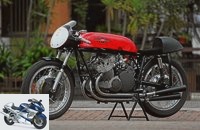
Racing machine Gilera 500 replica
Damn difficult and terribly expensive
Liberati’s loyalty to Gilera is unwavering
Five years earlier, Liberati had won the world championship title in the 500s. The last for Gilera, because at the end of that season the financially troubled Italians announced their withdrawal from Grand Prix racing. Domenico Agusta then tried to convince Liberati with a blank salary check to drive for him in the future. But Liberati did not see the Conte’s request as an opportunity, but as an attempt to shake his loyalty to Gilera. And gave the tempting offer a brusque refusal. He’d rather wait for the day when his employer competes at the World Cup again, so he dealt with the Conte.
Oxley
A memorial stone commemorates the unfortunate hero, who was very revered in his hometown.
When Gilera actually announced that he would be participating in the 1962 World Cup season, Liberati drove out of town on a rainy day to train his reflexes for such slippery conditions. However, on a winding downhill stretch outside Ternis, he lost control of his machine and crashed into a rock face, sustaining fatal injuries. A memorial stone at this point commemorates the hero who was so revered in his hometown as only a few pilots in the history of racing have been granted.
“Liberati was our city’s figurehead for many years,” says Sacchi. “Terni was completely destroyed during World War II. As you can imagine, people had other concerns than racing in the years that followed. But Liberati gave each of them the hope of someday fulfilling their dream of a better life. ”Terni lived – and still lives – from his steel industry, which is why the city, located around 100 kilometers north of Rome, is also known as“ Italian Manchester ”. No wonder that the city with all its armories was hit so badly by over 100 bomber attacks during the war.
Liberati won four of six Grand Prix in 1957
Liberati himself was a few months too young to be a soldier on the battlefield. In the post-war years, like almost everyone in Terni, he worked on rebuilding the steel industry. He competed in local motorcycle races in the late 1940s. He impressed his work colleagues so much with his courage and speed that for a few months they collected part of their not exactly lavish salary and lumped it into a pot to buy him a Moto Guzzi Dondolino 500. The daring racer Giuseppe Gilera had already noticed, whose pioneering dohc four-cylinder should dominate the 500cc world championship in the 1950s. He brought Liberati to the factory, where he was primarily supposed to support the three-time 500cc world champion Geoff Duke, who joined Gilera almost at the same time.
Liberati’s big chance did not come until 1957, when Duke injured himself in Imola and was out for a long time. He did not miss this opportunity: of the six Grand Prix that year he won four – in Hockenheim, Spa, Dundrod and Monza – and took the 500cc title for Gilera, ahead of his teammate Bob McIntyre, who replaces Duke therefore won the Senior TT. The 70 hp four-cylinder Gilera with its hemispherical combustion chambers and centrally positioned spark plugs continued to be the better motorcycle in 1957 compared to the MV Agusta four, which the year before was only able to claim the world championship title because Geoff Duke took several months was suspended after initiating a pilots strike at the 1955 Dutch TT. But compared to MV Agusta, Gilera was always ahead in engine development, and with Duke and Liberati, two pilots who could cope with the unpredictable handling of the 500.
Liberati’s title win also coincided with the end of the excessive disguises that were banned for safety reasons after the 1957 season. Like all works teams, Gilera always had a bodybuilder on the racetrack who could manually adjust the brittle panels made of an aluminum-magnesium alloy according to the aerodynamic requirements.
But just a few weeks after Liberati’s enthusiastic reception in his hometown, a joint statement by Gilera, Moto Guzzi, FB Mondial and MV Agusta shocked racing fans: the four economically troubled Italian works teams announced their immediate exit from the Grand Prix circuit. New, inexpensive small cars caused motorcycle registrations to continue to shrink, while at the same time the worries of the factories about safety grew ever greater: In the previous six years, 19 drivers had fatally injured in world championship races.
Oxley
On the way to victory: Libero Liberati on the four-cylinder Gilera at the Cervara road race.
A few weeks after this joint declaration, however, the Conte Agusta backed down – in contrast to the other motorcycle manufacturers, MV was able to offset the losses due to falling two-wheeler sales with the profits from the helicopter business. Thanks to this financial backing, MV managed to dominate the 500 World Championship for the next 17 years. Liberati, on the other hand, did not win a single Grand Prix after his decisive rejection of the princely offer from Conte Agusta. Instead, he had to make do with a Gilera Saturno 500, which he used in non-World Championship races, always hoping for a Grand Prix return from Gilera.
Sacchi paved the way for Rossi to enter the GP circus
Nevertheless, Liberati and Gilera are among the great passions of Giampiero Sacchi, who had two lifelong dreams: One was to lead the historic brand back to world championship titles, which seemed almost impossible. The other was a replica of Liberati’s 1957 world champion machine. The latter wasn’t impossible, but it was going to be damn difficult and terribly expensive.
In fact, Sacchi managed to make both dreams come true. After paving the way for Valentino Rossi into the Grand Prix circus in 1996 and leading him to the 125cc world champion title the following year, he took over the management of the Derbi GP team. When the Spanish brand was bought by Piaggio in 2001, he saw the opportunity to fulfill his first lifelong dream. Since Piaggio already owned Gilera, Manuel Poggialis 125cc Derbi was renamed Gilera. And so, with the pilot from San Marino, a Gilera finally won a world champion title again after more than four decades. A few years later, Sacchi repeated this “fraudulent label” with Marco Simoncelli’s Aprilia, who won his 250 World Championship title on a Gilera in 2008.
Pirro Loreti for engine and body
During this time, Sacchi began to realize his second dream. Gilera gave him access to the original design drawings of the 1957 four-cylinder engine back in 2006. He hired Pirro Loreti, Liberati’s loyal racing mechanic, to rebuild the engine and build the replica. Remo Venturi, a former MV and Gilera rider who took a Gilera four-cylinder’s last win in the Italian Championship in 1966, also played a role in the rebuild. Back when Venturi drove for MV and Liberati for Gilera, the two often shared a hotel room during race weekends. “What would be unthinkable today was actually normal with these gentleman pilots,” Sacchi smiles.
The special thing about his Gilera replica is the fact that it is the first to be created exactly to the hundredth of the original construction plans of the factory. The various replicas that were built in England at Meccanica Verghera, on the other hand, are copies of a collector’s machine. Sacchi knows that without the numerous supporters, without the approval of Gilera and without the help of Pirro and Remo, he would never have been able to get this project off the ground. “However, we received an enthusiastic yes from everyone we asked,” says the excited initiator, still happy today.
But Sacchi is very cautious when it comes to the names of the other key figures. What is certain is that many friends and business partners from the Italian motorsport industry did him a favor. For example, he doesn’t want to reveal who contributed the sand-cast magnesium engine housing and the engine’s innards. You can only elicit from him that these parts were not made by Gilera. Then he mumbles something about Modena and advises to let your imagination run wild. He also keeps a cloak of silence about the price of the replica. “Well, just reproducing the Dellorto carburettors cost 12,000 euros. But please don’t tell my wife … “, he finally smiles.
Oxley
Proud of their work: Sacchi with Liberati’s former mechanic Pirro Loreti (left) and the former MV and Gilera driver Remo Venturi (right).
Sacchi had only two copies of the four-cylinder Gilera built – one for himself, the other for Remo Venturi, the eighty-year-old bubbling over with joie de vivre, who is still fast in the Ferrari today. They are two absolutely precisely manufactured replicas that correspond to the original down to the smallest detail. With one exception: Both do without the massive, dome-like full fairing, because Sacchi did not want to hide this magnificent sculpture by Motor under any circumstances. The machine itself, which usually stands in Sacchi’s office, is not hidden either; it can be admired again and again at classical music events in Italy.
History of the Gilera engine
The Gilera four-cylinder was of course not the first motorcycle four-cylinder. In the early years, many manufacturers, such as Pierce and Henderson in the USA, Garabello in Italy or FN in Belgium, relied on the smooth-running drive. But here as there, the engine was installed lengthways, causing all sorts of problems, from the long wheelbase to overheating of the rear cylinder. During the 1920s, the Italian engineers Piero Remor and Carlo Gianini then turned the cylinders 90 degrees.
Water-cooled compressor motor assembled everything
However, this arrangement was not immediately successful. After various changes, a record-breaking machine emerged, the potential of which convinced Giuseppe Gilera – he bought this record-breaking project in 1936, which at the time blew everything up with its water-cooled compressor motor. With 274 km / h Piero Taruffi pulverized the world speed records of BMW and Brough Superior in the 500 and 1000 motorcycles in 1937.
Oxley
An engine as a sculpture: Gilera’s unmistakable four-cylinder with its symmetrical structure and curved lines is a feast for the eyes.
Two years later, Dorino Serafini beat the title favorite Georg Meier on his supercharged BMW with the Gilera in the European road championship. When the world federation FIM banned supercharged engines after the war, Remor built an air-cooled 500cc four-cylinder, which would prove to be the most powerful in the first World Cup season in 1949. Still, Gilera struggled to outdo the Norton single-cylinder. The Manx had around 25 percent less power, but with its double loop frame and hydraulic suspension elements it brought it to the road without any problems, while the Gilera pilots struggled more badly with their outdated chassis.
Remor went over to MV Agusta
At the time, Remor had fallen out with his boss and went over to MV Agusta, where he copied “his” four-cylinder. At Gilera, his former assistants came into play, who first threw the friction dampers on the trash and dramatically improved the chassis. Then they tickled more and more power from the engine. Early versions with two carburettors made 52 hp. But this brilliant basic construction had great potential. Many detailed improvements and the switch to four carburettors finally brought 70 hp in 1957, Liberati’s year of success – an increase of almost 40 percent! Because Remor left no stone unturned at MV to beat his former employees, Gilera went all out for 1958: With four-valve cylinder heads and 35 mm downdraft carburetors, the maximum output is said to have been increased to over 90 hp at 10,500 rpm. However, the Italians have not yet provided evidence of their withdrawal from Grand Prix racing
Related articles
-
Caught: Gilera 600 Super Sport
Caught: Gilera 600 Super Sport Stand of the rings After an eight-year break, the Italian brand with the rings in its logo is finally bringing a…
-
The plans of BMW and Gilera Secret thing MOTORRAD has thought: This is what BMW’s future projects could look like. The resurrection of the Gilera brand,…
-
Norton Manx F-Type replica in the studio
Bilski 17 pictures Bilski 1/17 One of the few photos that served as a template for the Norton Manx F-Type replica. Bilski 2/17 The “Norton-Franz” …
-
test Moto Guzzi V8 replica Guiseppe Todero built the legendary Moto Guzzi V8 racing machine on his own. One of the most famous factory racing machines…
-
Driving report Gilera Saturno 500
Rivas 33 photos Rivas 1/33 It is as rare as it is seldom beautiful, the Gilera Saturno 500. Rivas 2/33 Rivas 3/33 Rivas 4/33 Rivas 5/33 Rivas 6/33 Rivas…
-
fact 25th photos fact / Joachim Schahl 1/25 Werner Koch about the shek replica: Are such replicas even allowed to appear in a classic magazine? But of…
-
Yamaha RD 500 LC: Grand Prix replica with V4 two-stroke engine
fact 10 pictures archive 1/10 As elaborately as the engine and chassis were achieved, the cockpit was drawn so simply. Archive 2/10 The 16-inch device makes bends …
-
Scene: Hildebrand & Wolfmuller replica
Bilski Scene: Hildebrand Wolfmuller replica The first to the second Content of Hildebrand Wolfmuller are considered the first series-produced…
-
Kawasaki Z 1000 MK II Eddie Lawson Superbike replica
wolf 19th photos wolf 1/19 wolf 2/19 wolf 3/19 wolf 4/19 wolf 5/19 wolf 6/19 wolf 7/19 wolf 8/19 The owner Frank Bach about his Kawasaki Z 1000 MK II: It…
-
Rivas 6th photos Rivas 1/6 When the street single cylinder celebrated its rebirth in the 1980s, the most beautiful interpretation came from Italy. The…